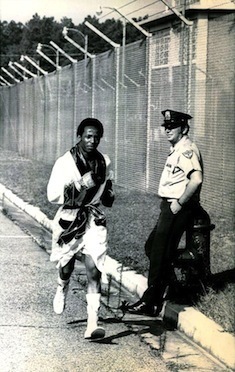Brendan I. Koerner's Blog, page 16
August 22, 2012
Simple Things

As I have previously explored, Bangladesh has some of the world’s most lethal roads. The nation’s motor vehicle-related fatality rate is about fifty times greater than in any Western country. As this piece makes clear, that sad fact is creating a massive drag on the Bangladeshi economy:
According to the World Health Organisation (WHO), road traffic injuries cause a loss of about 2% of GDP in Bangladesh, or about £1.2bn annually. This is almost equal to the total foreign aid received in a fiscal year.
Bangladesh currently lacks the enforcement mechanisms necessary to make people obey posted speed limits or buckle their seat belts. So what can be done to reduce the human and economic toll of motoring without asking too much of the state? Fortunately, there are some low-cost solutions that, at the very least, can save hundreds of lives (and millions of dollars) each year:
At the invitation of the ministry of communications, the International Road Assessment Programme (Irap) last year carried out assessments on the Dhaka-Sylhet and the Dhaka-Mymensingh highways, identifying design and maintenance flaws that are contributing to the growing toll of death and disability.
“We don’t want gold-plated roads,” says Greg Smith, Asia-Pacific regional director of Irap, who led the study. “With a scientific approach, sometimes a coat of white paint will save lives.”
According to this IRAP report, simply erecting median barriers on 30 miles’ worth of Dhaka’s highways would prevent 8,400 deaths and injuries every year. Bangladesh’s economy would get five dollars back for every dollar spent on such an investment, and the project could be completed in a matter of weeks assuming some small modicum of official commitment. Tough to imagine a more cost- and time-efficient way to reduce our species’ collective misery quotient.
August 21, 2012
Bobby Lee Hunter, Cont’d
One of the great joys of this whole Microkhan endeavor is reaching folks who might not otherwise have occasion to check out our work. And some of those good correspondents are not only interested observers, but also characters in the various yarns we unspool. Our recent post about the rise and fall of incarcerated pugilist Bobby Lee Hunter brought two such commenters out of the woodwork, both of them former world-class boxers. The first, Pat Cowdell, was an English fighter who lost a decision to Hunter at a London Hilton. The other, Tim Dement, was the man who ultimately denied Hunter’s Olympic dreams (see clip above); I’m reprinting his comment here in full, as it’s such a lovely testament to the strange camaraderie that can develop between men who are supposed to pummel each other for our enjoyment:
I also wondered what happened to my buddy Bobby Lee Hunter… We became friends in 1971 as team mates on the USA team that traveled to London and Russia to box. I was a light flyweight and Bobby was a flyweight. I have a newspaper clipping from London paper saying in the headlines “Tiny Tim Too Young to Fight.” I was just 16 years old. They would not allow me to box. However I enjoyed the fights however I had beaten the two Polish Champs aged 31 and 27.
Pat and I must be the same age. In London only men attended the matches all dressed in tuxedos. Pat did good with Bobby.
Bobby and I trained and sparred together in 1971 in Miami at the dog race track before he went to that Pan Am games and won a bronze.
Please take a second look at my match with Bobby at the 72 Olympic trails (see on YouTube) and tell me who won.
I understand they asked Bobby to box against me again at the box offs two weeks later and he refused. I told them please don’t ask him again. I did feel lucky. I love Bobby lee and would love see him again.
To thank Dement for his kind contribution to Microkhan, I am front-paging the clip of his Olympic Trials bout with Hunter. I still think it’s a close call as to who won, but I can see now that there’s no concrete reason to quibble with the judges’ decision.
Also: Howard Cossell, you are missed. Sorely missed.
August 20, 2012
Sly Like a Roach
 A terrific little crime yarn out of southern Colorado, where an exterminator has been sentenced to 21 years in prison for burglary. That punishment may sound harsh, but Charles Edward Trogdon was no run-of-the-mill breaking-and-entering specialist. He allegedly spent three decades nicking precious items from the homes of clients, a vocation that allowed him to support a suspiciously extravagant lifestyle. (How many snowmobiles and trips to Paris can the average exterminator afford?) Trogdon would likely still be at his illicit craft if he hadn’t made one careless error in 2010:
A terrific little crime yarn out of southern Colorado, where an exterminator has been sentenced to 21 years in prison for burglary. That punishment may sound harsh, but Charles Edward Trogdon was no run-of-the-mill breaking-and-entering specialist. He allegedly spent three decades nicking precious items from the homes of clients, a vocation that allowed him to support a suspiciously extravagant lifestyle. (How many snowmobiles and trips to Paris can the average exterminator afford?) Trogdon would likely still be at his illicit craft if he hadn’t made one careless error in 2010:
Trogdon was arrested Nov. 1, 2010, after a woman watched him enter her home without permission, open a dresser drawer and steal money where money previously had gone missing.
Authorities served multiple search warrants at Trogdon’s home and recovered dozens of items that had been stolen from other customers’ homes over a period of many years.
Trogdon said he purchased many of the items at local flea markets.
This detail, I believe, is the greatest testament to Trogdon’s criminal genius:
Trogdon lived an extravagant life, Champagne said. He had multiple houses, boats, snowmobiles and took trips around the world. He since has transferred all of his assets to his wife, preventing victims from obtaining restitution.
Amazing that such a loophole exists in Colorado’s legal code. I have to think that Trogdon knew about it for many years, and started the necessary paperwork as soon as he was arrested. He would thus be the rare crook blessed with some measure of foresight.
August 17, 2012
Knockoffs: Grizzly
In honor of Shark Week, I feel compelled to pick a killer-animal-on-the-loose flick for our second installment of Knockoffs. A year after Jaws set the standard for the genre, 28-year-old William Girdler made Grizzly, which rather shamelessly presented itself as a ursine-centric alterative to Steven Spielberg’s box-office hit. When one of your movie’s taglines is “The Most Dangerous Jaws on Land,” you’re obviously assuming that your audience will equate imitation with flattery.
Like all memorable knockoffs, Grizzly attempts to one-up is inspiration by ratcheting up the absurdity a notch. In Jaws, the shark of the title is eventually done in by the puncturing of a tank of compressed air. Girdler “improves” upon that finale by resorting to a favorite Microkhan trope: unnecessary rocket launcher use. (See also here and here.) The video above is all cued up to that glorious man-versus-beast confrontation, so just hit play and enjoy. And try to freeze the clip right at the 3:19 mark—the impact special effect is a wonder to behold.
A sad coda, though: Girdler died just two years later, while scouting film locations in the Philippines. He was working on yet another knockoff at the time, a Star Wars imitator that would have been called The Overlords (link SFW despite warning).
August 15, 2012
Deathboats
 In the midst of some maritime-related research, my mental record needle stopped upon reading this counterintuitive claim:
In the midst of some maritime-related research, my mental record needle stopped upon reading this counterintuitive claim:
Statistics indicate that lifeboats have cost more lives during training drills than they saved during actual rescue situations. The hook release system, which attaches the boats to the wire and winch that lowers them into the water, is the cause of about 80% of these accidents.
Really? So our species would actually be slightly in the plus column if we just left shipwreck victims to their own devices? It sounds too brutal to be true, but there is credible evidence to support the contention here:
In 2001 the Marine Accident Investigation Branch (MAIB) studied (PDF) the UK’s merchant fleet accident reports for ten years and it showed that alongside entering confined spaces and falling overboard, lifeboat practice was the most dangerous area of operation. Sixteen per cent of fatalities happen during lifeboat drill – one death in eight – a chilling statistic.
MAIB concluded that there were major three factors in lifeboat training accidents which in the studied decade killed 12 seafarers and injured a further 87. Ironically over the same period they did not record one single instance where someone was saved by a lifeboat.
The report emphasized deficiencies in lifeboat design, maintenance and training. Their findings were confined to UK waters and therefore only pointed towards the global problem, but they were backed up by the Norwegian and Australian authorities with their separate investigations coming to similar conclusions. The Norwegians estimate that globally there are about 214,000 drills a year causing 1,000 accidents and as many as half causing fatalities.
So let’s say that puts us somewhere around 500 fatalities per year due to lifeboat accidents. How does that compare to how many lives the small vessels save annually? That’s tougher to calculate, for there do not seem to be any international statistics. On top of that, we do need to question whether lifeboats launched from shore to rescue shipwreck victims are equivalent to those stored on the ships themselves. But there is one data point from the United Kingdom here, and it definitely hints at the fact that the claims of lifeboats’ overall lethality could hold water.
None of this may be good reason to jettison lifeboats from ships. But perhaps the maritime industry should follow Allen Iverson’s fabled lead and disdain the practice of practice.
August 14, 2012
True Heroism

Made it back from Helsinki late last night, but too dazed today to be of much use to y’all. That’s largely because I did the noble thing on the flight back home: I yielded my aisle seat to a young Dutch woman who was keen to be next to her boyfriend. My reward was a middle seat smushed between two fidgety types who made sleep impossible. Throw in jet lag and the ravages of a Nordic alcohol bonanza, and you can hopefully understand why I’ll spend most of today barely holding onto reality. Back tomorrow with something worth your while.
August 10, 2012
Helsinki
By the time you read these words, I’ll be exploring the streets of Finland’s capital. It’s a quick trip, as I don’t want to miss the birth of the heiress to the Grand Empress’s throne. But while I’m here, I will likely to be blotto on sahti to keep pace with Microkhan. See you upon my return to Queens early next week.
August 9, 2012
Confessions of a Snake Eater
An in-depth perusal of the Sword Swallowing Hall of Fame led me to this gem of Victorian non-fiction—an anonymous first-person account of a life spent shoving dangerous objects down one’s gullet. Our storyteller’s most curious pursuit involves the ingestion of a reptile with which our species has a complicated relationship:
I was the second one that every swallowed a snake. I was about seventeen or eighteen when I learnt it…The snakes I use are about eighteen inches long, and you must first cut the stingers out, ‘cos it might hurt you…
When I first began swallowing snakes they tasted queer like. They draw’d the roof of the mouth a bit. It’s a roughish taste. The scales rough you a bit when you draw them up. You see, a snake will go into ever such a little hole, and they are smooth one way.
The head of the snake goes about an inch and a half down the throat, and the rest of it continues in the mouth, curled round like. I hold him by the tail, and when I pinch it he goes right in. The tail is slippery, but you nip it with the nails like pinchers. If you was to let him go, he’d go right down; but most snakes will stop at two inches down the swallow, and then they bind like a ball in the mouth.
Read the whole thing. It’s like the most gothic Studs Terkel interview ever.
August 8, 2012
The Wages of Transparency

Techno-pessimists have long argued that the democratization of media will not shame elites into better behavior, but will rather make them more cautious about conducting their dirty business behind well-secured doors. The Euthanex AgPro, which is marketed as “the ultimate humane CO2 solution” for the dispatching of pigs, provides one small data point in favor of that viewpoint:
At VAST, we realized that blunt force trauma was not viable in this age of potential Youtube exposure. We also realized that homemade CO2 systems had many problems. We wanted to design a product that was humane, efficient, worker friendly and eliminated negative variables. In short, we would only accept the best possible solution.
As an enthusiastic devourer of swine, I find this a bit disconcerting. Why shouldn’t we be exposed to the brutality of our gustatory choices? I don’t think carnivores will find such visual evidence as off-putting as Big Agriculture fears. It wasn’t all that long ago, after all, that no human could eat meat without having to hack off a chunk of wooly mammoth with their stone blade. I’m not sure why modern businesses think we need to be entirely divorced from that process.
August 6, 2012
The Curious Case of Bobby Lee Hunter
 Per the usual, the Olympic boxing tournament has been something of a farce, with scoring scandals predictably aplenty. Every four years, such controversy reminds me of the tale of Bobby Lee Hunter, a once-celebrated boxer I have been trying to locate for the better part of a decade.
Per the usual, the Olympic boxing tournament has been something of a farce, with scoring scandals predictably aplenty. Every four years, such controversy reminds me of the tale of Bobby Lee Hunter, a once-celebrated boxer I have been trying to locate for the better part of a decade.
Hunter was a world-beating American flyweight who seemed certain to represent his country at the 1972 Olympics in Munich. This prospect made the powers-that-be quite uncomfortable, for there was something rather unique about Hunter—namely, the fact that he was serving 18 years in a South Carolina prison for manslaughter. Hunter, who trained in the prison yard, was allowed to travel to international competitions with a chaperone, and he was America’s reigning AAU champion when he attended the U.S. Olympic trials in July 1972. The International Olympic Committee shuddered at the thought of Hunter in Germany, with the ever-controversial Avery Brundage openly questioning whether a convict could represent the true Olympic spirit.
A political confrontation was averted, however, when Hunter mysteriously lost to an unheralded fighter named Tim Dement at the Olympic trials. As footage of that bout shows, Dement’s victory was anything but clear cut; the decision could easily have broken for Hunter, and one has to wonder whether the judges felt some pressure to leave the killer at home. (Not to take anything away from Dement, who seems like a cool cat.)
I have long yearned to follow up with Hunter, to see how this experience changed him, for better or for worse. But the trail goes cold in the South Carolina penal system: Hunter was paroled in 1973, but then re-arrested for aggravated assault in 1977. As you might imagine, South Carolina used to keep poor records on the fates of its released convicts, and Hunter’s name is so common that the brute-force approach of cold calling phone numbers isn’t feasible here.
Anyone have a line on what may have become of Bobby Lee Hunter after his boxing career didn’t pan out? Let me know.




